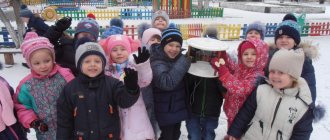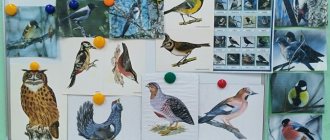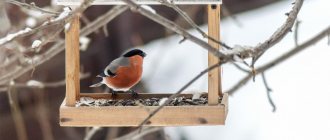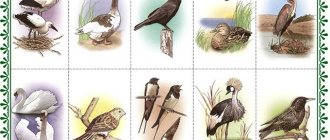Project “Birds of our region”
Project topic
:
“Birds of our land”
Project type
: informational and creative.
Project participants:
2nd grade students, parents, teacher.
Objective of the project:
the formation of ecological knowledge about the birds of their native land, their way of life, and a responsible, caring attitude towards them.
Tasks:
— Clarify ideas about familiar birds, their habitat conditions, and the role of humans in the lives of birds.
— Expand children's horizons about birds. To promote the development of creative and intellectual abilities of younger schoolchildren.
-Develop observation and cognitive activity of children.
— Involve children and parents in helping birds in difficult winter conditions. Foster a caring attitude towards feathered friends, teach them to take care of the birds in their immediate environment.
Methods of work: conversations, selection of literature, Internet.
Form of work: playful, educational, productive, work with parents.
Relevance of the project:
The problem of environmental education of the younger generation is one of the most pressing. In modern conditions, the problem of environmental education of junior schoolchildren becomes particularly acute and relevant. It is during this period that the formation of the human personality and the formation of the principles of environmental culture take place. Therefore, it is very important to awaken children’s interest in living nature, cultivate a love for it, and teach them to take care of the world around them.
The project is complex in nature: it includes practical environmentally oriented, creative, aesthetic activities, physical activity of children, and promotion of respect for nature.
The theme of the project “Birds are our friends” was not chosen by chance. After all, it is birds that surround us all year round, bringing benefits and joy to people. During the cold season, there is significantly less available food, but the need for it increases. Sometimes natural food becomes practically unavailable, so many birds cannot survive the winter and die. And we, teachers, together with parents, must teach children to see this, expanding their understanding of birds, their habits and way of life, and create conditions for the child to communicate with the natural world.
All work on the project was carried out under the guidance of the teacher. In the process of working on the project, the children showed independence. They took an active part in collecting information and made observations.
Stages of implementation of the project “Birds of Our Land”.
- Preparatory stage.
-Collection of information .
-Accumulation, development and design of material (educational conversations, lessons of literary reading, the surrounding world, mathematics, Russian language, poetry, stories, fairy tales, riddles, proverbs, signs, physical education lessons)
- Main stage (practical)
— Carrying out the “Feed the birds in winter” campaign (making feeders);
— Excursion into nature
3. The final stage.
— Registration of work results. (drawings, wall newspaper, bird passport, crafts) - Class hour “Birds are our friends”
- Presentation
Stages of implementation of the project “Birds of Our Land”.
I. Preparatory stage.
The beginning of work on the project was a visit to the school library. Working with encyclopedias “What? When? Why?”, children's magazines, articles.
During the lessons of literary reading, the Russian language, and the surrounding world, children became acquainted with works about birds.
Conversations were held: “Rules of attitude towards birds”, “What are birds for”, “What would have happened if there were no birds”...
During mathematics lessons, they solved examples in coloring books, solved crosswords and charades.
We have prepared messages about the birds of our region, proverbs, sayings, and signs.
II Main
stage (practical).
Winter is a difficult time for birds, especially if it is harsh and snowy. And it is precisely at this time of year that wintering birds especially need human help, as they experience an acute shortage of food. A hungry bird suffers greatly from the cold. And we can support the birds in winter, help them and watch them. Children observed the life of birds during the excursion and in everyday life.
After research, the guys came to the conclusion that the birds need to be helped, and it was decided to hold a competition for the best feeder. The feeders were made from different materials, and the children and their parents actively got involved in the work.
III. Final stage (results of work)
At the final stage of work in the visual arts and technology lessons, we drew pictures for the exhibition, made crafts, and created a collective wall newspaper.
Project in kindergarten in the senior group. Wintering birds
Project “Wintering birds of our region”
“Nature is the only book, every page is full of deep content” I.V. Goethe 1. Brief abstract of the project: Preschool childhood is a crucial period of human life: the foundations of a correct attitude towards the surrounding world (nature) are laid , things, people), value orientation in it. Fostering love and respect for the native land and nature is the most important component of moral education. To raise a good citizen who wants to protect and protect nature, you need to know it. Forming an understanding that man is part of nature, he must preserve, protect and defend it, that everything in nature is interconnected. Developing the ability to behave correctly in nature and protect it. 2. Project type: Educational, creative, short-term. Implementation time: 2 weeks. Project participants: children of the senior group of kindergarten, teachers. Venue: group, kindergarten area. 3. Relevance of the project: In modern conditions, the problem of moral, labor and environmental education of preschool children becomes particularly acute and relevant. It is during preschool childhood that the formation of human personality occurs. Therefore, it is very important to awaken in children an interest in living nature, to cultivate a love for it, to teach them to protect the world around them and take care of it. The theme of the project “Birds in Winter” was not chosen by chance. After all, it is birds that surround us all year round, bringing benefits and joy to people. During the cold season, there is significantly less available food, but the need for it increases. Sometimes natural food becomes practically unavailable, so many birds cannot survive the winter and die. And we, teachers, together with parents, must teach children to see this, expanding their understanding of wintering birds, their habits and way of life, and create conditions for the child to communicate with the natural world. 4. Statement of the problem Insufficient understanding of children about wintering birds. Children do not have enough understanding of the lifestyle, habits, nutrition and homes of wintering birds, and how they feed in the winter. 5. Goals and objectives of the project: To cultivate a careful, caring, responsible attitude towards wintering birds, to form ecological knowledge about them. Project objectives: for children:
to expand children’s knowledge about wintering birds, to form a caring, responsible attitude towards the natural world, basic environmental knowledge;
cultivate a desire to help birds in difficult winter conditions; learn to reflect your attitude to the natural world in productive activities. for parents:
to create activity and interest in the educational process;
involve in the manufacture of bird feeders and their feeding; teach parents to show their children by personal example how to treat nature with care, protect and care for it. for teachers:
to replenish the subject-development environment on the topic of the project, to introduce effective methods and techniques into the educational process to expand children’s knowledge about wintering birds.
6. Expected result: for children:
have an idea of wintering birds;
understand that it is easier for birds to endure harsh winters when people take care of them; know how to make a feeding trough together with their parents; they know how and what food to feed the birds; are able to observe and analyze their own activities; show care and responsibility towards the environment. for parents:
show great interest in the life of children in kindergarten;
assist the child in performing creative work; active project participants. for teachers:
closer cooperation with the families of pupils.
7. Activities for project implementation: Stage 1 Preparatory Setting project goals, determining knowledge, relevance of the project; selection of methodological literature, visual and didactic material, fiction, photographs; organization of a development environment. Conversations with parents about the need for their participation in the project, about a serious attitude towards the educational process in the preschool educational institution. Stage 2 Practical Cognitive development:
1. GCD “Wintering birds” 2. Conversation “Wintering and migratory birds” 3. Conversation “What does a bird need more, warmth or food?”
4. Conversation “Why does the feeder need a roof?” 5. Didactic games: “Guess by description” Purpose: to teach how to write a descriptive story about the proposed bird without showing it. “Counting Birds” Purpose: to strengthen children’s ability to coordinate numerals with nouns. “Call it affectionately” Purpose: to practice word formation (tit-titmouse, sparrow-sparrow). “The fourth odd one” Purpose: to consolidate children’s knowledge about wintering birds and their appearance. Physical development
1. Morning exercises.
2. Outdoor games: “Crows”, “Birds sitting in nests”, “Sparrows and a car”, “Owl”, “Sparrows and a dog”, “Wintering and migratory birds” (with a ball. 3. Finger gymnastics: “How many birds flew to our feeder", "Come, birds", "Feeder", "Magpie", "The birds flew in", "Woodpecker". 4. Rhythmic exercise: "Bullfinches" Artistic and aesthetic development:
Drawing - "Bullfinch on a branch" Construction from paper “Titmouse” Modeling - “Sparrow from a cone” Research activity - examination and examination of feathers; - name parts of the body; - coloring; - what they eat; - Life Lifestyle: Conversation “What to feed birds?” “How to help birds;” Reading fiction literature: V. Sukhomlinsky “How the titmouse wakes me up”, O. Grigorieva “Titmouse”, L. Voronkova “Bird feeders”, V. Zvyagina “Sparrow”, T. Evdoshenko “Take care of the birds”, Y. Nikonov “Winter guests”, M. Gorky “Sparrow.”
Speech development
1. Examination of the poster “Wintering Birds.” 2. Examination of illustrations, photographs on the topic: “Birds,” “Birds at the feeder.”
3. Reading and discussion of proverbs and sayings about wintering birds. 4. Memorizing A. Yashin’s poem “Feed the birds in winter” Activities on a walk Tour of the kindergarten grounds. Bird watching. Labor - cleaning up broken branches on the site. Joint work with parents Fix the name of wintering birds, draw a poster of birds in winter Advise to go on an excursion to the forest or park. Work with a speech therapist on this topic. 3. Final stage Design of the exhibition “Wintering Birds”. View the summary presentation: “Birds in winter.” Hanging feeders on the site. Design of the laptop “Wintering Birds” As a result of the work done, the children learned: What types of birds remain to spend the winter in our area, and which ones fly to us for the winter; How to distinguish birds by color; What food do birds prefer? The following conclusions were made: Birds become noticeable and more active as the weather warms up; the brighter the sun shines, the more birds there are on the street, the more active they are; Birds do not fly on windy days; As food, pigeons and sparrows prefer seeds, and tits prefer lard; Sparrows, pigeons (They rarely appear, there are more of them in the city), waxwings fly in flocks, tits in 3-4 groups, crows - alone. 5 species of birds visited the feeder; During the project, the birds have become accustomed to receiving food, so feeding must be continued.
We recommend watching:
Summary of organizing a joint educational activity with children of the younger group. Birds in winter Summary of GCD in the middle group. Wintering birds Poems for children 4-6 years old on the topic: Birds in winter Summary of educational activities in the senior group: Birds in winter
Similar articles:
Winter holiday in grades 1-2. Scenario “Caring for Birds in Winter”
Conversation in kindergarten on the topic: “Wintering birds” in the preparatory group
A story about a pigeon, grades 1-2. The world
A story about a canary for children, grades 1-2





